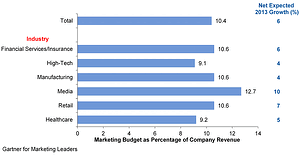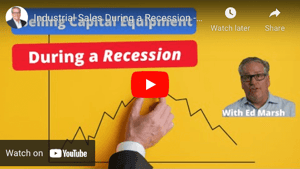Tl;dr - Many manufacturing companies aren't sure what their marketing budget should be, and there's not a lot of guidance available. As digital marketing efforts become more common, and the typical prospects of a manufacturing company do their research online, marketing spend needs to increase. The good news is that digital marketing can be more closely tracked than traditional marketing methods, and lead costs are generally lower. But rather than base this year's marketing spend on last years budget plus a bit, zero-based budgeting can be effective to determine an appropriate manufacturing marketing budget.
Building a Manufacturing Marketing Budget from the Ground Up
 If I told you that your manufacturing marketing budget should be 5% of revenue, you'd probably guffaw. That's vastly different than what most manufacturing businesses typically invest. However, traditional offline marketing methods (trade shows) don't address contemporary buyer expectations.
If I told you that your manufacturing marketing budget should be 5% of revenue, you'd probably guffaw. That's vastly different than what most manufacturing businesses typically invest. However, traditional offline marketing methods (trade shows) don't address contemporary buyer expectations.
Digital marketing strategies, marketing automation tools, educational content, technical SEO aspects of industrial manufacturing websites, search engine optimization and other tactics require a larger investment than on legacy marketing tactics.
That means we need to retool expectations for marketing budgets to accommodate digital marketing efforts. The good news is that as marketing does more of the traditional sales job, resources can be shifted.
A Zero Based Budget Approach to Manufacturing Companies' Marketing Budget Planning
In an October 2022 email I suggested that companies consider zero-based budgeting for their revenue growth (marketing, sales & technology) budgeting process for 2023. The following is an excerpt.
Building a 2023 Revenue Growth Budget for your company
If your sales and marketing budgeting process is like most companies', you start with this year's forecast and make some small adjustments up or down. Maybe you debate the size of trade show booths, hiring another rep or engaging an SEO consultant. But generally, the process starts with last year's budget and tweaks from there.
Is that the right approach? It's certainly the easiest and most comfortable. But how much has the market changed, what new technology has been introduced, and how have buyer behaviors changed since you set the original baseline for the current budget ten or twenty years ago?
The short answer is A LOT!
So maybe it's time for an interesting planning exercise there. Even if you just run it in parallel as a thought excercise.
Consider zero-based budgeting for your revenue growth team. If you were starting today with the current brand awareness and customer base, how could you most effectively hit your revenue goals? What institutional cruft (a software term that refers to what's left over, redundant and getting in the way) impedes success? Or diverts resources into traditional but less impactful spending? There's probably a lot.
What's the right size and composition of your sales team? Inside sales? Field sales? Number hitting quota, etc. What's the balance of inbound vs. outbound lead gen and sales? What gaps are there in your technology, website, PR and competitive marketing?
Even if you don't end up using the zero-based budget in next year's final plan, you'll have a much richer understanding of how your revenue growth team should be resourced. And maybe there will be some tweaks you'll want to make. If this is intriguing, I'm happy to book some time to show you a framework I've used and talk through considerations.
This week the Wall Street Journal noted that many companies are taking this approach.
One area to which finance chiefs scouting for efficiencies have turned is zero-based budgeting, a tool that gained popularity early in the pandemic and requires finance executives to question and justify each line item in every new budget period. More traditional budgeting techniques, in contrast, involve adjusting the previous year’s spending, taking into account economic forecasts and other factors....And finance chiefs say that this time around they are looking for more selective changes than in 2020, ones that will help bring expenses down permanently. They are seeking to identify savings in areas including operations, real estate, logistics, sales and marketing. Some are focusing on their selling, general and administrative expenses, while others are slowing hiring.
What Should Your Industrial Marketing and Sales Budget Be?
 Short answer, if you're an industrial manufacturer I can confidently tell you it should be higher than it is. Obviously I'm biased. But I also have the opportunity to work across industries, and in technology - in addition to capital equipment. In my experience most middle-market machinery companies spend 1-2% of revenue on marketing, with most going to trade shows. An appropriate target for today's market environment is 5%.
Short answer, if you're an industrial manufacturer I can confidently tell you it should be higher than it is. Obviously I'm biased. But I also have the opportunity to work across industries, and in technology - in addition to capital equipment. In my experience most middle-market machinery companies spend 1-2% of revenue on marketing, with most going to trade shows. An appropriate target for today's market environment is 5%.
The budget of most companies is inadequate to provide the information and experiences that prospects, buyers and customers expect. It's too heavily skewed toward non-performing field sales and away from manufacturing marketing and technology.
Morgan Housel (@MorganHousel) articulated the challenge in a recent Collaborative Fund post.
In dynamically changing businesses and industries, often great managers / businesses and experts are wrong because they were great / experts in a past version of reality.
The article's context was successful investing, but the same applies to many business decisions. The trade show marketing, "brochure" website, and casual field sales approach that has gotten companies to where they are will not carry them to the next levels of growth...or even help them maintain current revenue as pressures from market conditions and buyer expectations intensify.
So here are some additional resources pulled from the article archives to consider as you massage your '23 budget looking for places to economize and redirect resources for maximum revenue impact. And if a short meeting would be helpful to work through some of the considerations and implications - of even just to vent about the challenge of change in traditional companies, then let's book something.
How Deeply to Slash a Manufacturing Marketing Budget in a Recession?

November 11, 2022 - Tl;dr - When recession hits, there's pressure to cut costs. Although excesses shouldn't accumulate to begin with, data can guide cuts to marketing and sales when they're required. Here's how to approach tough decisions on recession cost cuts in industrial sales and manufacturing marketing. (read more)
Is your B2B marketing budget too high? Too low? Just right?
 February 21st, 2014 - Tl;dr - Different industries have structurally different models. Consumer goods and technology invest differently in marketing than industrial manufacturers. While it wouldn't work to simply drop one model into a company in a different industry, buyers are increasingly conditioned to expect B2C experiences which will require manufacturers to spend more to improve their B2B positioning. (read more)
February 21st, 2014 - Tl;dr - Different industries have structurally different models. Consumer goods and technology invest differently in marketing than industrial manufacturers. While it wouldn't work to simply drop one model into a company in a different industry, buyers are increasingly conditioned to expect B2C experiences which will require manufacturers to spend more to improve their B2B positioning. (read more)
How to Construct a Manufacturing Marketing and Sales Technology Budget
 May 27th, 2022 - Tl;dr - Traditional industrial sales organizations are often startled as they begin to explore the marketing and sales technology space. There are numerous technologies they should have, some that would be nice to have, and many that are useless. But how should a manufacturer that has traditionally spent little on marketing technology build a budget? Here's a comprehensive overview. (read more)
May 27th, 2022 - Tl;dr - Traditional industrial sales organizations are often startled as they begin to explore the marketing and sales technology space. There are numerous technologies they should have, some that would be nice to have, and many that are useless. But how should a manufacturer that has traditionally spent little on marketing technology build a budget? Here's a comprehensive overview. (read more)
Digital Marketing Strategy for Manufacturing Industry in Recession
 June 24th, 2022 - Tl;dr - Marketing is marketing. Marketing is sales. Sales is sales. Sound convoluted? Maybe, but it's critical to understand to prepare your business now for revenue growth during the recession ahead. (read more)
June 24th, 2022 - Tl;dr - Marketing is marketing. Marketing is sales. Sales is sales. Sound convoluted? Maybe, but it's critical to understand to prepare your business now for revenue growth during the recession ahead. (read more)
Maintaining Complex Machinery Sales in a Recession
 June 18th, 2022 - Tl;dr - Capital equipment companies should use the strong order flow now to prepare for coming recession. They should take three steps. Deep understanding of buyers, optimizing sales talent, digging deep into sales process and enablement. (read more)
June 18th, 2022 - Tl;dr - Capital equipment companies should use the strong order flow now to prepare for coming recession. They should take three steps. Deep understanding of buyers, optimizing sales talent, digging deep into sales process and enablement. (read more)
And finally, positioning your company for rapid growth as we emerge from recession.
Steady Hand on the Revenue Growth Throttle as Economic Recovery Nears
 Sept 30th, 2022 - Tl;dr - Most capital equipment companies seek to survive a recession. Some sidestep most of the pain. But few look across the trough to create amazing revenue growth opportunities. Here are ideas to help your company use a recession and economic recovery as an amazing springboard for growth. (read more)
Sept 30th, 2022 - Tl;dr - Most capital equipment companies seek to survive a recession. Some sidestep most of the pain. But few look across the trough to create amazing revenue growth opportunities. Here are ideas to help your company use a recession and economic recovery as an amazing springboard for growth. (read more)
Final Thoughts on Setting Your Marketing Budget for an Industrial Manufacturer
As we get more analytical about manufacturing company marketing budgets, it's clear that the landscape is continually evolving, and the allocation of resources is more critical than ever. In the manufacturing industry, where traditional methods have long been the norm, adapting to the digital age is imperative. That means some nuances of marketing budgets, the significance of marketing automation, and how manufacturing businesses can navigate these changes in line with industry trends.
Marketing Budgets in the Digital Age
Gone are the days when a modest spend on marketing (mostly just industry events) sufficed. With the advent of digital advertising and the shift in consumer behavior towards online research, manufacturing companies must reconsider their marketing budgets. While it might seem daunting to allocate more resources, it's a necessity to stay competitive in today's market. For frame of reference, 5% of revenue for the marketing budget is a reasonable planning number, with more on technology budgeting here.
The Role of Marketing Automation
Marketing automation has emerged as a game-changer in the manufacturing industry. It streamlines marketing efforts, making them more efficient and data-driven. By integrating marketing automation tools with CRM and sales technology, manufacturing businesses can not only reduce manual tasks but also gain valuable insights into customer behaviors and preferences.
Collaborating with Marketing Agencies
In this digital era, partnering with marketing agencies well-versed in the manufacturing sector can yield significant benefits. These agencies bring industry-specific expertise, helping companies navigate the complexities of digital marketing, content creation, and SEO strategies effectively. But an agency isn't always the best answer. Sometimes a manufacturing marketing consultant is a better fit.
Adapting to Industry Trends
Manufacturing businesses must keep a vigilant eye on industry trends. Adapting to changing market dynamics and consumer expectations is vital for sustained growth. Staying ahead of the curve in terms of technology, B2B industrial website development, and competitive marketing strategies can position a company for success.
Not Your Father's Marketing Budget
The world of marketing budgets in the manufacturing industry is undergoing a profound transformation. To thrive in today's market conditions, companies must be willing to invest more strategically in digital advertising, embrace marketing automation, and align their strategies with industry trends. This proactive approach will not only enhance brand visibility but also contribute to sustainable revenue growth in this ever-evolving landscape.



